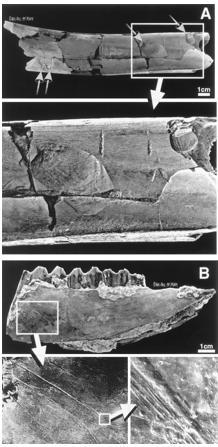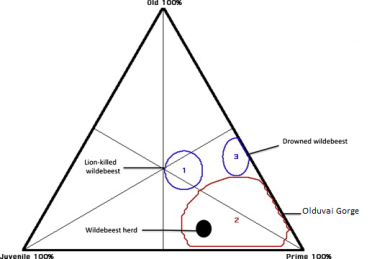Modern humans eat more meat than any other living ape. Although chimps have been seen hunting with spears, meat still only makes up ~3% of their diet yet it can constitute 70% of the diet of a hunter-gatherer1. The earliest evidence we have of our ancestors meat eating is 2.6 million year old cutmarks on animal bone. Yet the species doing this cutting was still very ape-like, with small bodies and brains3. This raises the question, could the early meat eaters have hunted their prey, or would they have had to rely on scavenging?

Some 2.6 million year old bones with stone tool cutmarks
This is question is complicated by the fact that many of the bones with cutmarks also have evidence of carnivores gnawing on them3. Could this mean that hominins were simply scavenging the kills of other animals, or were the carnivores trying to steal from early humans? Identifying the order in which these marks were made has been seen as key to resolving the debate.
This research typically focuses on watching how carnivores eat bones and using that to predict where their tooth marks should be if they got first pick of the carcass4. For example, some species like to go straight for the bone marrow. So if it turns out that it was the hominins who managed to crack open the bones and suck out the marrow, they were the ones who got to the carcass first (and so likely hunted and killed it). Unfortunately this is easier said then done and its proven difficult to figure out whether the chicken or the egg hominin or the carnivore came first, with most research providing conflicting results e.g.2,3,4
Fortunately a new method may help answer the question! Rather than looking at the cutmarks, these scientists examined the bones themselves. See, humans aren’t just unique because we eat a lot of meat. We also kill animals in a unique way. As every nature documentary ever will tell you, lions and other predators tend to focus on the sick, weak and old members of the herd. Humans, on the other hand, have tools and so can go straight for the prime adults with the best cuts of meat5.
So the researchers examined the “population” of dead animals at Olduvai Gorge, a 1.8 million year old site that has provided most of the evidence of early humans cutting up animals. They predicted that if most of the animals at the site were prime adults then this would be strong evidence against other carnivores being the primary culprit. They also looked at the sort of dead population left behind after animals die en masse. After all, even if predators weren’t killing the animals, hominins could still simply be exploiting carcasses left behind after a flash flood. In this case they looked at Lake Masek in Africa, through which Wildebeast migrate. If the lake happens to be full of water at the time, this can lead to mass drownings5.
When they compared all these dead populations to Olduvai Gorge, they found none of them matched. Most of the animals at the site were adults in their prime, the sort of thing you wouldn’t expect to see if wild animals had killed them. This provides some compelling evidence that the early humans at the site were actively hunting and killing the animals, rather than simply scavenging other carnivores’ kills. They also didn’t match the spread of individuals seen at Lake Masek, providing more evidence that hominins were the animal-murderers responsible5.

The mortality profiles for bovids that drowned, were killed by lions and found at Olduvai Gorge
When trying to extrapolate from the present to the past sample size is key. That way you can be sure any effect you identify is valid and not just the result of natural variation. Whilst this research did examine a large sample of lion-killed Wildebeast, they didn’t examine much else5. Perhaps hyenas kill in a pattern more similar to that seen at Olduvai Gorge. Maybe a flash flood leaves a different trace than mass drownings on a migration route. etc. Its a first step towards showing early humans were hunting but it is by no means definitive proof.
Nonetheless, it is good evidence of early humans hunting by at least 1.8 million years ago. Even more interestingly, it shows them focusing on prime adults, just like modern humans do. Despite the fact they only had handheld stone tools and a brain half the size of ours they were still able to kill the same animals as us. Perhaps we aren’t quite as advanced as we like to think.
References
- Boyd and Silk, 2012. How Humans Evolved. 6th ed. London: W. W. Norton & Company
- Blumenschine, R. J., Prassack, K. A., Kreger, C. D., & Pante, M. C. (2007). Carnivore tooth-marks, microbial bioerosion, and the invalidation of test of Oldowan hominin scavenging behavior. Journal of Human Evolution, 53(4), 420-426.
- Blumenschine, R. J. (1995). Percussion marks, tooth marks, and experimental determinations of the timing of hominid and carnivore access to long bones at FLK Zinjanthropus, Olduvai Gorge, Tanzania. Journal of Human Evolution,29(1), 21-51.
- Pante, M. C., Blumenschine, R. J., Capaldo, S. D., & Scott, R. S. (2012). Validation of bone surface modification models for inferring fossil hominin and carnivore feeding interactions, with reapplication to FLK 22, Olduvai Gorge, Tanzania. Journal of human evolution, 63(2), 395-407.
- Bunn, H. T., & Gurtov, A. N. (2013). Prey mortality profiles indicate that Early Pleistocene Homo at Olduvai was an ambush predator. Quaternary International.

